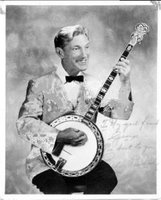Monday, November 28, 2005
More on Eddie Peabody

The Red Hot Jazz Peabody website on Eddie Peabody is outstanding (www.redhotjazz.com/peabody.html) . I'm amazed at the quality of sound that was drawn from these old 78 rpm records. These early recordings should serve as a primer for beginning plectrum banjo players as well as advanced players wanting to review the basic elements of syncopated chord melody playing. These recordings also illustrate the genius of Peabody in developing variations in building banjo solos through the unique strokes that he originated. The problem for banjoists has often been: When you've played the tune through once, what do you do the next time around for variety. In addition to his jazzy variations, Peabody also drew on the verse in many cases, something you seldom hear from banjoists nowadays. He also sang in his so-so stage voice for the same purpose. Peabody was definitely a first in laying the groundwork in modern plectrum banjo playing. Early plectrum banjo players before him, such as Banjo Bill Bowen and Alfred Farland, came from a tradition of classic five-string banjo and tried to adapt that idiom, not as successfully, to playing with a pick. Peabody did not have that background and came out with a style that was pure plectrum banjo. He did this in a relatively short time between his discharge from; the United States Navy after World War One until leaving his career as a dance band banjoist in the mid-1920s to become a banjo headliner in vaudeville. Working unamplified in theaters and often unaccompanied in the recording studio, he developed a full chord melody technique for maximum power and fullness of sound that didn't leave much room for thinner single string acrobatics. This was a boon for companies for which he recorded in the early years because they only had to pay one musician, or at the most two if another vocalist was used, for a very saleable record. How many of today's banjoists would have the courage to go into a recording session with only a banjo and no backup musicians?
Peabody is sometimes compared unfairly to Harry Reser. The two had completely different approaches to banjo playing which cannot be considered on a competitive basis. Each had a niche of his own. Peabody was the supreme show banjoist and Reser was the supreme recording studio and orchestral banjoist. Each adapted his style to the idiom in which he was making a living. Peabody once told me during a jam session in his later years that when he was on stage he was not playing for banjo players but for the audience.That philosophy gave him a career with his banjo for half of a century. He showed what he could really do in those sessions with other banjoists. Professional banjoists of more recent times have developed their own styles, but if you listen closely, you can almost always hear Peabody in the background. This is certainly the case with Buddy Wachter, a modern day genius of the banjo who has gone on from there to where no banjoist has gone before.
When I finish production of my "The Banjo Entertainers: Roots to Ragtime" banjo history book, I'll check out my collection of Peabody recordings to see if I can help activate some of the listed titles that do not yet have sound. If I have any of better sound quality, I'll also make a note of those. On listening to this collection, I'm of the opinion that Peabody's best 78 rpm recordings were made in 1931 in London where he had excellent backup. That left him free to concentrate on really playing without filling all the holes himself. I also think highly of the 1938 London Decca recordings. My favorite is "Lambeth Walk." Unfortunately these examples have suffered from too many generations of dubbing, as you're aware. I hope your newsletter readership can track down better or original copies of the 1938 recordings. However, I realize the bombings of World War II were tough on fragile 78s, and a low quality listen to these are still better than none at all.
Best Wishes,
Lowell Schreyer